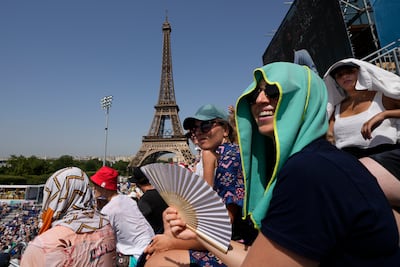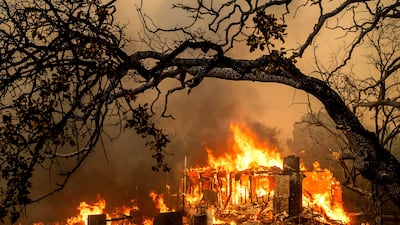Climate change created an extra six weeks of dangerous heat for the average person in 2024, and fuelled more prolonged heatwaves in most of the Middle East, scientists revealed on Friday.
People typically endured 41 more days of extreme heat than they could expect in a world without global warming, according to calculations by researchers at World Weather Attribution and Climate Central. In the Middle East, the number of “risky heat days” rose to 70 in Saudi Arabia, 67 in Egypt and 50 in the UAE. Risky heat days are those that hit unusually high temperatures by the standards of recent decades.
On one sweltering day – Sunday, July 21 – more than five billion people were enduring conditions that were once only half as likely. Climate scientists called heatwaves a “silent killer” that catch people by surprise because of unseasonal conditions, a lack of early warning systems and a less dramatic “trail of destruction” than storms or wildfires.
They said 2024 was the first year in which temperatures were 1.5°C higher than in pre-industrial times, a key benchmark in the fight against climate change. One year does not mean the world has failed to limit global warming to 1.5°C because the target refers to a long-term average, but the report called it a “warning that we are getting dangerously close”.
“Virtually every heatwave has been made hotter and more likely because of climate change,” said the report, When Risks Become Reality: Extreme Weather In 2024. “This signal is so clear and so widespread that in many parts of the world we no longer need individual attribution studies to say this with confidence.”
The El Nino effect, which naturally warms the Pacific Ocean and influences meteorological conditions around the world, was another factor behind 2024's extreme events. But researchers said climate change played a bigger role and “increasingly overrides other natural phenomena affecting the weather”.
During 2024, Saudi Arabia said more than 2,500 Hajj pilgrims suffered heat exhaustion in 51.8°C temperatures, while the Paris Olympics and football's Africa Cup of Nations took place in sweltering heat. In April, doctors in Mali reported a surge in excess deaths as temperatures climbed to nearly 50°C. Hot seas and warmer air were also blamed for fuelling more destructive storms, including Hurricane Helene and Typhoon Gaemi, and downpours in the UAE and in North America.
Vulnerable nations in the Caribbean and the Pacific topped the table of “risky heat days”, with a typical person in Nauru facing 173 days of extreme conditions, almost half the year. Most Middle East countries were above the 41-day global average, as Egypt, Lebanon, Syria, Jordan and Qatar saw eight to 10 extra weeks of unusual heat.
Days classified as “risky” were those that people would consider hot based on their local experience, defined as temperatures that would have been in the warmest 10 per cent from 1991 to 2020. In cooler Europe, three to four weeks of unusual heat were typical – in countries such as Britain, Germany and France.
Scientists said early warning systems were one of the cheapest and most effective ways to cut heat deaths. Although most extreme weather is well forecast, warnings should be targeted, given days ahead of dangerous conditions, and give clear instructions on what people need to do, they said.
“People don’t have to die in heatwaves. But if we can’t communicate convincingly: ‘but actually a lot of people are dying’, it’s much harder to raise this awareness,” said Friederike Otto, an Imperial College London scientist who jointly runs World Weather Attribution. “Heatwaves are by far the deadliest extreme event, and they are the extreme events where climate change is a real game changer.”
The bio
Favourite book: Peter Rabbit. I used to read it to my three children and still read it myself. If I am feeling down it brings back good memories.
Best thing about your job: Getting to help people. My mum always told me never to pass up an opportunity to do a good deed.
Best part of life in the UAE: The weather. The constant sunshine is amazing and there is always something to do, you have so many options when it comes to how to spend your day.
Favourite holiday destination: Malaysia. I went there for my honeymoon and ended up volunteering to teach local children for a few hours each day. It is such a special place and I plan to retire there one day.
Specs
Engine: Electric motor generating 54.2kWh (Cooper SE and Aceman SE), 64.6kW (Countryman All4 SE)
Power: 218hp (Cooper and Aceman), 313hp (Countryman)
Torque: 330Nm (Cooper and Aceman), 494Nm (Countryman)
On sale: Now
Price: From Dh158,000 (Cooper), Dh168,000 (Aceman), Dh190,000 (Countryman)
Cryopreservation: A timeline
- Keyhole surgery under general anaesthetic
- Ovarian tissue surgically removed
- Tissue processed in a high-tech facility
- Tissue re-implanted at a time of the patient’s choosing
- Full hormone production regained within 4-6 months
UAE currency: the story behind the money in your pockets
Greatest Royal Rumble match listing
50-man Royal Rumble - names entered so far include Braun Strowman, Daniel Bryan, Kurt Angle, Big Show, Kane, Chris Jericho, The New Day and Elias
Universal Championship Brock Lesnar (champion) v Roman Reigns in a steel cage match
WWE World Heavyweight ChampionshipAJ Styles (champion) v Shinsuke Nakamura
Intercontinental Championship Seth Rollins (champion) v The Miz v Finn Balor v Samoa Joe
United States Championship Jeff Hardy (champion) v Jinder Mahal
SmackDown Tag Team Championship The Bludgeon Brothers (champions) v The Usos
Raw Tag Team Championship (currently vacant) Cesaro and Sheamus v Matt Hardy and Bray Wyatt
Casket match The Undertaker v Rusev
Singles match John Cena v Triple H
Cruiserweight Championship Cedric Alexander v Kalisto
MATCH INFO
Barcelona 5 (Lenglet 2', Vidal 29', Messi 34', 75', Suarez 77')
Valladolid 1 (Kiko 15')
ARSENAL IN 1977
Feb 05 Arsenal 0-0 Sunderland
Feb 12 Manchester City 1-0 Arsenal
Feb 15 Middlesbrough 3-0 Arsenal
Feb 19 Arsenal 2-3 West Ham
Feb 26 Middlesbrough 4-1 Arsenal (FA Cup)
Mar 01 Everton 2-1 Arsenal
Mar 05 Arsenal 1-4 ipswich
March 08 Arsenal 1-2 West Brom
Mar 12 QPR 2-1 Arsenal
Mar 23 Stoke 1-1 Arsenal
Apr 02 Arsenal 3-0 Leicester
Fight card
1. Featherweight 66kg: Ben Lucas (AUS) v Ibrahim Kendil (EGY)
2. Lightweight 70kg: Mohammed Kareem Aljnan (SYR) v Alphonse Besala (CMR)
3. Welterweight 77kg:Marcos Costa (BRA) v Abdelhakim Wahid (MAR)
4. Lightweight 70kg: Omar Ramadan (EGY) v Abdimitalipov Atabek (KGZ)
5. Featherweight 66kg: Ahmed Al Darmaki (UAE) v Kagimu Kigga (UGA)
6. Catchweight 85kg: Ibrahim El Sawi (EGY) v Iuri Fraga (BRA)
7. Featherweight 66kg: Yousef Al Husani (UAE) v Mohamed Allam (EGY)
8. Catchweight 73kg: Mostafa Radi (PAL) v Ahmed Abdelraouf of Egypt (EGY)
9. Featherweight 66kg: Jaures Dea (CMR) v Andre Pinheiro (BRA)
10. Catchweight 90kg: Tarek Suleiman (SYR) v Juscelino Ferreira (BRA)
The%C2%A0specs%20
%3Cp%3E%0D%3Cstrong%3EEngine%3A%20%3C%2Fstrong%3E6-cylinder%2C%204.8-litre%20%0D%3Cbr%3E%3Cstrong%3ETransmission%3A%20%3C%2Fstrong%3E5-speed%20automatic%20and%20manual%0D%3Cbr%3E%3Cstrong%3EPower%3A%20%3C%2Fstrong%3E280%20brake%20horsepower%20%0D%3Cbr%3E%3Cstrong%3ETorque%3A%20%3C%2Fstrong%3E451Nm%20%0D%3Cbr%3E%3Cstrong%3EPrice%3A%20%3C%2Fstrong%3Efrom%20Dh153%2C00%0D%3Cbr%3E%3Cstrong%3EOn%20sale%3A%20%3C%2Fstrong%3Enow%3C%2Fp%3E%0A
Empty Words
By Mario Levrero
(Coffee House Press)
The specs
Engine: 2.0-litre 4cyl turbo
Power: 261hp at 5,500rpm
Torque: 405Nm at 1,750-3,500rpm
Transmission: 9-speed auto
Fuel consumption: 6.9L/100km
On sale: Now
Price: From Dh117,059
The specs: 2018 Audi R8 V10 RWS
Price: base / as tested: From Dh632,225
Engine: 5.2-litre V10
Gearbox: Seven-speed automatic
Power: 540hp @ 8,250rpm
Torque: 540Nm @ 6,500rpm
Fuel economy, combined: 12.4L / 100km
Match info:
Manchester City 2
Sterling (8'), Walker (52')
Newcastle United 1
Yedlin (30')
THE BIO
Occupation: Specialised chief medical laboratory technologist
Age: 78
Favourite destination: Always Al Ain “Dar Al Zain”
Hobbies: his work - “ the thing which I am most passionate for and which occupied all my time in the morning and evening from 1963 to 2019”
Other hobbies: football
Favorite football club: Al Ain Sports Club
Jetour T1 specs
Engine: 2-litre turbocharged
Power: 254hp
Torque: 390Nm
Price: From Dh126,000
Available: Now
RESULTS
2pm: Handicap (PA) Dh40,000 (Dirt) 1,000m
Winner: AF Mozhell, Saif Al Balushi (jockey), Khalifa Al Neyadi (trainer)
2.30pm: Maiden (PA) Dh40,000 (D) 2,000m
Winner: Majdi, Szczepan Mazur, Abdallah Al Hammadi.
3pm: Handicap (PA) Dh40,000 (D) 1,700m
Winner: AF Athabeh, Tadhg O’Shea, Ernst Oertel.
3.30pm: Handicap (PA) Dh40,000 (D) 1,700m
Winner: AF Eshaar, Bernardo Pinheiro, Khalifa Al Neyadi
4pm: Gulf Cup presented by Longines Prestige (PA) Dh150,000 (D) 1,700m
Winner: Al Roba’a Al Khali, Al Moatasem Al Balushi, Younis Al Kalbani
4.30pm: Handicap (TB) Dh40,000 (D) 1,200m
Winner: Apolo Kid, Antonio Fresu, Musabah Al Muahiri
How%20to%20avoid%20getting%20scammed
%3Cul%3E%0A%3Cli%3ENever%20click%20on%20links%20provided%20via%20app%20or%20SMS%2C%20even%20if%20they%20seem%20to%20come%20from%20authorised%20senders%20at%20first%20glance%3C%2Fli%3E%0A%3Cli%3EAlways%20double-check%20the%20authenticity%20of%20websites%3C%2Fli%3E%0A%3Cli%3EEnable%20Two-Factor%20Authentication%20(2FA)%20for%20all%20your%20working%20and%20personal%20services%3C%2Fli%3E%0A%3Cli%3EOnly%20use%20official%20links%20published%20by%20the%20respective%20entity%3C%2Fli%3E%0A%3Cli%3EDouble-check%20the%20web%20addresses%20to%20reduce%20exposure%20to%20fake%20sites%20created%20with%20domain%20names%20containing%20spelling%20errors%3C%2Fli%3E%0A%3C%2Ful%3E%0A
It Was Just an Accident
Director: Jafar Panahi
Stars: Vahid Mobasseri, Mariam Afshari, Ebrahim Azizi, Hadis Pakbaten, Majid Panahi, Mohamad Ali Elyasmehr
Rating: 4/5
Dates for the diary
To mark Bodytree’s 10th anniversary, the coming season will be filled with celebratory activities:
- September 21 Anyone interested in becoming a certified yoga instructor can sign up for a 250-hour course in Yoga Teacher Training with Jacquelene Sadek. It begins on September 21 and will take place over the course of six weekends.
- October 18 to 21 International yoga instructor, Yogi Nora, will be visiting Bodytree and offering classes.
- October 26 to November 4 International pilates instructor Courtney Miller will be on hand at the studio, offering classes.
- November 9 Bodytree is hosting a party to celebrate turning 10, and everyone is invited. Expect a day full of free classes on the grounds of the studio.
- December 11 Yogeswari, an advanced certified Jivamukti teacher, will be visiting the studio.
- February 2, 2018 Bodytree will host its 4th annual yoga market.
THE SPECS
Engine: Four-cylinder 2.5-litre
Transmission: Seven-speed auto
Power: 165hp
Torque: 241Nm
Price: Dh99,900 to Dh134,000
On sale: now
Skewed figures
In the village of Mevagissey in southwest England the housing stock has doubled in the last century while the number of residents is half the historic high. The village's Neighbourhood Development Plan states that 26% of homes are holiday retreats. Prices are high, averaging around £300,000, £50,000 more than the Cornish average of £250,000. The local average wage is £15,458.
Learn more about Qasr Al Hosn
In 2013, The National's History Project went beyond the walls to see what life was like living in Abu Dhabi's fabled fort:
The specs: 2017 Porsche 718 Cayman
Price, base / as tested Dh222,500 / Dh296,870
Engine 2.0L, flat four-cylinder
Transmission Seven-speed PDK
Power 300hp @ 6,500rpm
Torque 380hp @ 1,950rpm
Fuel economy, combined 6.9L / 100km



